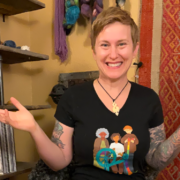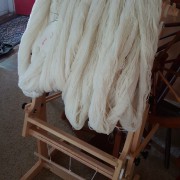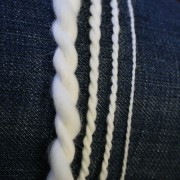Ask Jacey: How Do I Improve My Joins?
I’ve heard lots of people talk about how there are different joins for different kinds of spinning. I’m not even super good at the one join I do (I kind of tease out the fiber at the end of my new yarn and then lay new fiber over it and hope it all gets twisted together when I start treadling again). Is that a good join and are there better ones? Will you cover these in the guild? ~Melanie, PA, USA
Dear Melanie,
Joins are something many spinners struggle with, so you are absolutely not alone. There are several different types of joins and lots of ways to do each of them. What you want to learn (and practice) is a good join for the types of yarns you spin (and yes, we’ll cover every join imaginable in the guild).
Before I get too far into different joins and how to do them, I want to say this to newer spinners: Don’t let this get in your head. If you’re new to spinning and you are getting any join to stay together, rejoice and keep spinning. Joining can be hard at first (I promise it will get easier, automatic even). Come back to expanding your joining repertoire later, when you’re comfortable and ready. This is not something you must know right now. Okay, for Melanie and anyone ready to work on joins, here we go.
Different joins for different yarn
I’m not sure what kind of yarns you spin, but maybe you spin enough different types of yarns that one join doesn’t suit them all. If you sometimes spin woolen and sometimes spin worsted (or even sometimes semi-woolen and sometimes semi-worsted), you’ll want a join for each of those. After all, a woolen yarn is fuzzy, airy, and lofty, and you probably don’t want smooth flat spots at each place you had to join new fiber (which you’d get if you use a worsted join on a woolen yarn). Conversely, a worsted yarn is smooth, lustrous, and dense, and you don’t want a fuzzy, airy, matte spot standing out wherever you joined, right?
Things that are true for every join
- You are always joining fiber to fiber, never fiber to yarn. If you don’t have a bit of fiber opened at the end of the yarn you’re spinning, stop and tease a bit out.
- Your new fiber and old fiber should not act like they are new or old. They should act like the same fiber, as if they’re all from the same fiber source.
- The area of yarn with the join should be the same diameter as the rest of your yarn. If that’s not possible – and we’re not machines so it’s often not – it should be thinner than the surrounding yarn. Twist goes to and stays in thinner areas of yarn, so if the area with your join is thinner, it’ll hold together better. If it’s thicker and your join isn’t perfect, it won’t hold.
A worsted join
I’ve seen worsted joins done so many different ways, but a few things should be true:
- Allow no twist between your hands
- Smooth and compress fibers after you make the join
- Keep both the old fiber and the new fiber under equal tension
- Do a short forward draft during the join, even if you’re otherwise spinning short backwards
As long as you do those things, your worsted join will look just like the rest of your worsted yarn. The key now is making sure your worsted join is secure. That key is mostly in those last two points plus the points that are true for every join – equal tension, using a short forward draft, joining fiber to fiber, treating the new fiber like the old fiber, and making the area of join the same or a thinner diameter. I made a short video to show you what I mean (remember that this is just one type of worsted join; there are others).
A woolen join
I find woolen joins to be a bit easier than worsted joins. Woolen yarns are more grabby than worsted yarns and also not quite as picky. There are several ways to do a woolen join, but they all have a few things in common. Those things they have in common are the things that make these yarns woolen instead of worsted:
- Let twist between your hands
- Don’t smooth the fibers
- Don’t compress the fibers; leave that air in there
As long as you’re doing those three things, you’re making a woolen join that won’t stick out in your woolen yarn. But just like the worsted join, you also want to make sure it’s secure. Since woolen yarns are a little more in chaotic than worsted yarns, the process for making a join is less specific. You just need to get the two fiber sources together, thinking they’re one, and introduce twist to them. My favorite way to do this is to take the new fiber and fold it around the last little bit of yarn I spun (making sure there’s some unspun fiber at the end), draft it forward or backwards just a bit, letting the fibers catch, then continue drafting. It sounds easy because it is! I made a short video of a woolen join here (again, remember that this is just one way to do a woolen join).
Experiment and find your joins
So that’s it! But not really, right? These are just guidelines (and one video example of each join). As long as you follow the guidelines for each type of join, experiment and see what works for you. You can still tease your fiber end out and then lay them together. In fact, that could be the start for either a woolen or a worsted join. Just make sure that the amount of fiber you have teased out won’t twist together and make a bulkier section in your yarn.
From there, you just have to change what you do next to fit the yarn you’re spinning. If it’s woolen, let twist enter those two teased-out sections without straightening them out or aligning the fibers. Resist smoothing your hands over the join (I say resist because I always want to). If it’s a worsted yarn you’re spinning, you do want to straighten out those teased fibers and keep your hands surrounding the fiber, one in front of what will be the join and one behind it. Slowly let twist enter the two fiber sources that are teased together, smoothing and compressing as you also start to draft again.
It might feel like a lot of things happening at once, but that’s the nature of spinning, right? Everything is happening all at once but you’ll get it, and don’t worry if it doesn’t work the first time – it’s only two inches of fiber, so just break it off and start again. That’s the beauty of spinning. We make it inch by inch, and if we’re unhappy with a particular inch, it’s just an inch.
Good luck,
jacey










Leave a Reply
Want to join the discussion?Feel free to contribute!